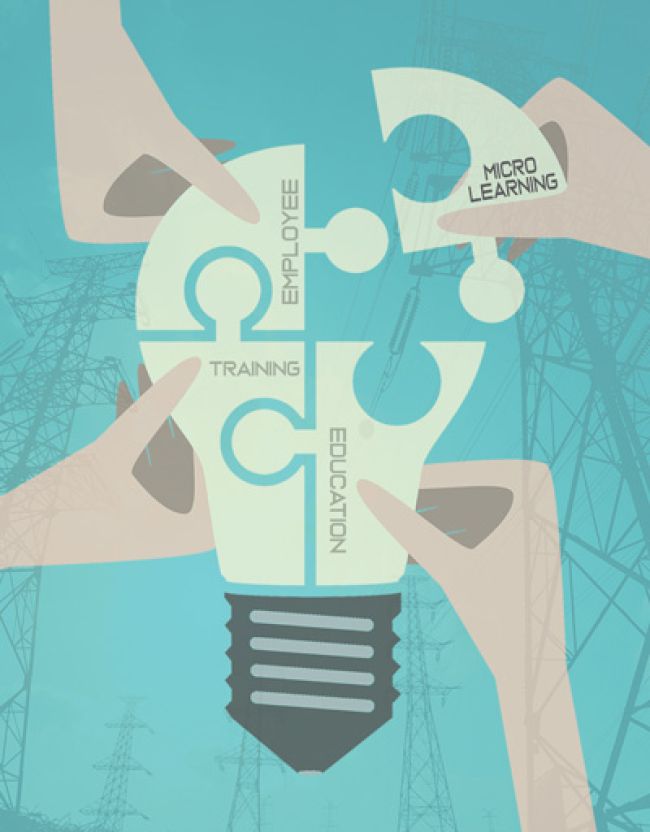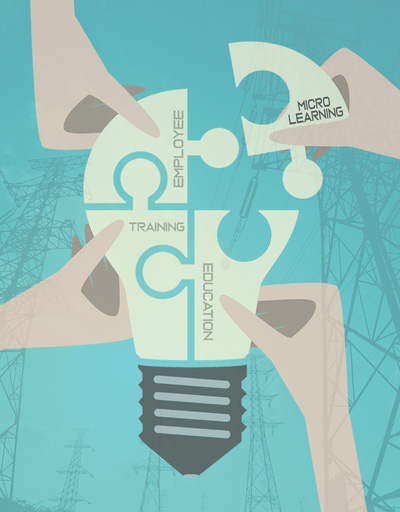
Microlearning: Another Critical Piece of the Employee Training Puzzle

Few people involved in helping others learn new skills suggest that doing so is easy. In the electric utility industry – or any industry, for that matter – training typically ranges from the informal, on-the-job variety to more formal classroom-type training. The results from each continue to be mixed.
In the past 10 to 15 years, we’ve also seen training evolve to include computer-based education. And over just the past several years, another type of training – referred to as “microlearning” – has started to take off. So, what is microlearning? And why should you bother educating yourself about it? Those are both great questions. Let’s consider them and the relevance of microlearning to the electric utility industry.
What is Microlearning?
Just as the word sounds, microlearning is an approach to training that involves smaller-than-usual educational units. Yikes – that’s a bad thing, right, especially in electric utility line work, where the information needed to understand and carry out the work can be dense and somewhat complicated? Not so fast. In reality, microlearning is the process of intentionally taking large blocks of mission-critical content and breaking them down into bite-sized chunks, so that individuals can use that information at the point of greatest impact. Thus, microlearning is not about shrinking the amount of information; rather, the information is distilled to its critical elements so that it can be readily accessed by those who require the knowledge in order to safely and accurately perform specific activities.
When used effectively, microlearning is a powerful performance support tool that can be accessed by a leader or team member at a point of critical need to increase the likelihood that decisions made or actions taken will be those needed to accomplish specified goals. The microlearning might involve two sentences of a critical policy. It might involve an interactive decision tree on responding to a lights-out ticket. It might involve a 30- to 90-second video clip on effective job setup. Or, it could involve parts of all three.
Think of microlearning this way: If you are in a hurry to get to an important event and you ask a person with you what time it is, what is it that you want in that moment? Are you looking for a long story about the history of timekeeping devices? Are you seeking an explanation of how time zones differ? What about an explanation of how circadian rhythms impact how tired you might be based on the time? No, what you actually want the other person to do is to simply look at a clock and tell you the time. And that is the basic function of microlearning.
Let’s say you are in a bucket truck facing a task that is somewhat complex, yet needs to be performed safely, efficiently and effectively. Is it practical to lower the bucket, drive back to the training yard and ask a trainer if you can go back through a class? Do you have the time to lower the bucket to read through the thick manual behind the seat? Can you lower the bucket to spend 45 minutes watching an e-learning video on the principles of the task at hand? No, no and heck no. Instead, what if you possessed an easily searchable channel of content, perhaps on a smartphone, that contained a three-step decision tree regarding ways to approach the task given several key variables – all based on accurate industry and company technical information?
To summarize, microlearning is the intentional access of small, manageable bits of information that are critical and lend themselves to success on the job.
What is the Purpose of Microlearning?
It’s important to note that the purpose of microlearning is not to replace or eliminate other types of training any more than personal protective equipment is a replacement for careful observation and effective job site setup. Used properly, PPE extends and enhances the impact of careful observation and effective job site setup. PPE also addresses potential gaps and risks not addressed by careful observation and effective job setup. Carefully created microlearning content distills critical information from other training elements, extending, enhancing and reinforcing them at the time the information is needed, thereby supporting high levels of productivity and effectiveness.
Microlearning content also addresses three issues that reduce the impact and measurable return on investment of training, including training in the electric utility industry. Those issues are the forgetting curve, providing content in a manner that is consistent with accepted adult learning theory, and getting impact-producing content into the hands of members of distributed workforces.
Taming the Forgetting Curve
The forgetting curve – first studied and described by German psychologist Hermann Ebbinghaus in the 1880s – visually documents how a person’s retention of information declines over time, assuming the person does not actively attempt to retain the information. Within 24 hours, and despite our best efforts in instructor-led or computer-based training, individuals may forget a majority of the content taught to them. So, where does that leave a team member on, say, the lights-out call referenced earlier in this article – even if he or she has undergone extensive classroom training about transformers, fuses and related topics? In short, it potentially leaves that worker in a real jam. Perhaps more often than most of us would like to admit, we find ourselves hoping our employees remember important content presented during training.
But in the electric utility industry, do we really want to be hoping? Aren’t workers more valuable than that? Aren’t customers’ needs more significant than that? Isn’t our organization’s reputation for doing the job right the first time worth more than merely hoping our workers remember what they’ve learned in training?
The forgetting curve can lead to tremendous risk, inefficiency, inconsistency and error as individuals attempt simple to complex electric utility tasks in the days after their training sessions. Fortunately, it is already being demonstrated – in fast-paced production environments requiring the retention of large bodies of information – that microlearning greatly reduces stress, inefficiency, inconsistency and errors by providing bite-sized chunks of content in real time, busting the forgetting curve in the chops.
Addressing Adult Learners’ Needs
Between 1980 and 1984, educator Malcom Knowles researched and asserted five characteristics of adult learners. Those characteristics include adult learners taking a much more active part in their education, plus moving away from lengthy instructor-centered sessions and toward smaller blocks of content designed to provide assistance with solving real-time workplace problems, whether technical or interpersonal. Microlearning mirrors these characteristics. Its flexible, on-demand nature enables a lineworker to move from passive participant in an instructor-centered training class to active participant in his or her own work task learning needs, increasing that individual’s motivation and engagement.
Equipping Distributed Workforces
The final of the three training issues that microlearning addresses – and the one that involves the most direct cost to employers – is equipping individuals in distributed workforces. The logistics of traditional training can be both a production and a financial nightmare for workforces spread out over large geographical areas. Microlearning addresses these challenges because educational materials typically are accessible on mobile platforms, in addition to desktop and laptop computers. And although some in your company might assert that older generations will not embrace microlearning via mobile device, let me ask you a question: The last time you or an older co-worker ordered a pizza, did you first look in a phone book to find the restaurant’s telephone number? No, it’s most likely you found the number after performing an internet search, and you may have even placed your order using a mobile app. The reality is that mobile learning is increasingly the way all of us – regardless of age – are educating ourselves.
Conclusion
Job-related training and education are an evolving puzzle most companies are trying to solve. As technology continues to advance, so does our ability to provide critical information to workforces in ways that highly motivate and engage adult learners. And in the fast-paced world of electric utility work, our ability to provide current information – data that is relevant to an individual’s task at hand and usable in the moment to work safely and successfully – is becoming more and more significant as adult learners adapt to the ability to electronically access information pertinent to other areas of their lives. It appears that microlearning is here to stay.
About the Author: Bart Castle is a consultant who has spent over 10 years focusing on learning and development. During that time, he has worked with a number of electric utility organizations on topics including serious incident investigations, safety program elements and training, leadership development and organizational development. Today, Castle consults with and supports forward-thinking organizations as they begin their transition to digital training models, including mobile and microlearning. He can be reached at 817-500-8202.

